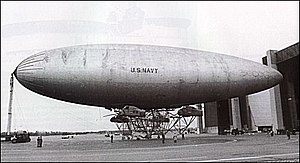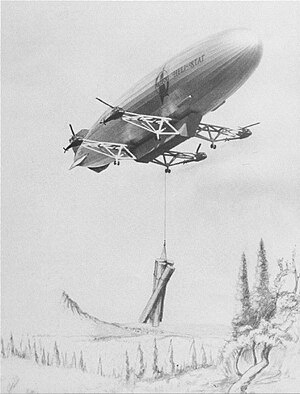Piasecki helicopter stat
The Piasecki Heli-Stat , also: Piasecki PA-97, was a test arrangement for the transport of heavy loads through the air, carried out by the Piasecki Aircraft Corporation in the mid-1980s . An airship was combined with four helicopter rotors as a float so that it could be used as a transport airship .
The Heli-Stat consisted of the airship part of a US naval airship of the type ZPG-2W , which was supposed to provide the static lift , and four helicopter rotors, which came from Sikorsky S-58 helicopters and were to provide the dynamic lift. The controls are essentially the same as for a conventional helicopter. The four rotor units were linked together and were controlled by one of the helicopter pilots. The pilots in the other machines only monitored their equipment.
The client was the US Navy , who wanted to provide the US Department of Forestry with evidence that it is possible to use aircraft to log logging in difficult terrain in a cost-effective and ecological manner. Developments for the transport of loads up to 200 tons were planned.
Development began in Lakehurst in 1979 . In 1984 the support frame for the four rotors had to be redesigned because it had failed in a stress test. The first flight of the machine with the registration number N1897Z took place on April 26, 1986 .
On July 1, 1986, the machine crashed and was completely destroyed. One of the pilots was killed, three others were seriously injured and one was slightly injured. The accident was u. a. documented with film recordings.
During the flight tests, a drop in performance in helicopter 3 was found. Thereupon the experiments were stopped and the machine should be put on the anchor mast . Shortly before mooring, a gust of wind hit the aircraft. The pilot could not compensate the movements on the ground with the controls available to him and tried to take off. The makeshift landing gear, which had no brakes or dampers, began to vibrate and rock, which was carried over to the entire construction. As a result, the helicopters broke off from the construction.
The drop in performance in helicopter 3 was attributed in the flight accident report to a missing part in the connection of the throttle control system. Additional factors were added:
- Vibrations in the chassis
- Vibrations of the rotor system
- No brakes on the chassis
- no control of the chassis
Technical data of the prototype
| Parameter | Data |
|---|---|
| drive | 4 Wright R-1820 -84A with 1,122 kW (1,525 PS) each |
| width | 60.50 m |
| length | 74.07 m |
| Empty mass | 24,895 kg |
| Flight mass | 50,469 kg |
| Top speed | 132 km / h |
| Service ceiling | 3,810 m |
| Maximum range | 3,307 km |
| Range with max. Payload | 80 km |
| planned payload | 26,000 kg |
Similar projects
- On July 8, 2008, Boeing announced its intention to develop, together with the Canadian company SkyHook, a device very similar to the Heli-Stat for a payload of up to 40 t under the designation JHL-40 (Jess Heavy Lifter). In 2010 the project was stopped due to lack of funding. Government support in the order of 100 million US dollars would have been necessary. The cost of developing the first prototype was estimated at 220 million dollars.
Web links
Individual evidence
- ↑ Boeing press release of July 8, 2008 ( Memento of July 21, 2013 in the Internet Archive )
- ↑ Focus article from September 13, 2010 at http://www.focus.de/finanzen/news/unternehmen/boeing-luftschiff-traeume-erst-einmal-geplatzt_aid_550956.html

